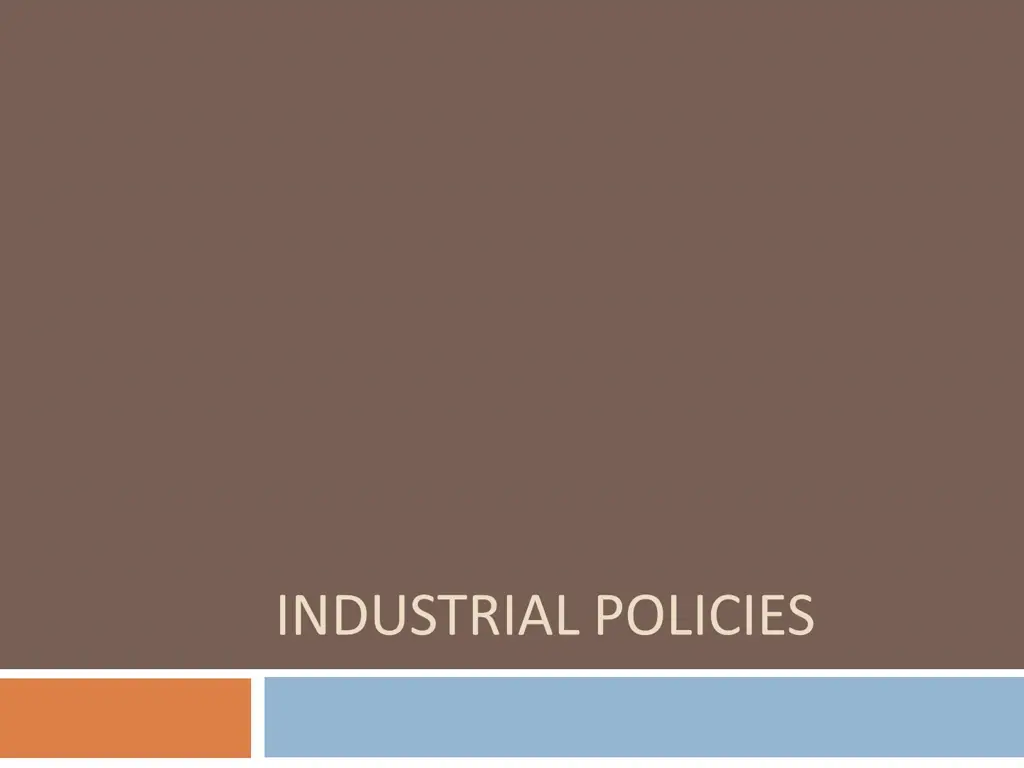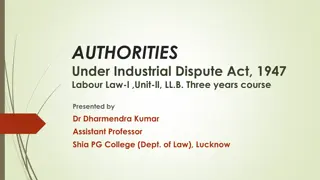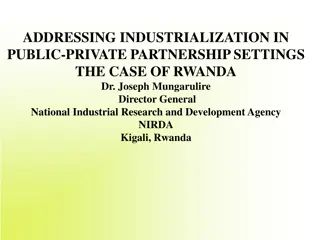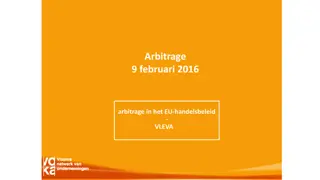Industrial Policies: Evolution, Objectives, and Impact
This study material explores the meaning, objectives, and evolution of industrial policies in India from 1948 to 1991. It discusses the role of industrial policies in achieving socialistic patterns of society, promoting industrial development, reducing regional disparities, and more.
Download Presentation

Please find below an Image/Link to download the presentation.
The content on the website is provided AS IS for your information and personal use only. It may not be sold, licensed, or shared on other websites without obtaining consent from the author.If you encounter any issues during the download, it is possible that the publisher has removed the file from their server.
You are allowed to download the files provided on this website for personal or commercial use, subject to the condition that they are used lawfully. All files are the property of their respective owners.
The content on the website is provided AS IS for your information and personal use only. It may not be sold, licensed, or shared on other websites without obtaining consent from the author.
E N D
Presentation Transcript
Disclaimer: The study material provided to our students of BBA of Department of Business Management is solely for the purpose of teaching and learning and has been obtained from varied sources. I do not claim for the originality of the content /resources/reading materials (PPTs, PDfs, You Tube Contents, Book Pdfs, Videos) shared as my own creation, as the contents/reading resources are a compilation from varied sources including open access sources and these are shared for the instructional and learning purpose by the students. I acknowledge and thankful to the sources, websites content writers and authors for their generosity in hosting their contents for wider dissemination and use. Dr. Rahil Yusuf Zai DoBM, IGNTU
Industrial Policy | Meaning Industrial policy means rules, regulations,principles,policies and procedureslaid down by governmentfor regulating,developing,and controlling industrialundertakingsin the country. It prescribesthe respective roles of the public, private, joint, and co-operativesectors for the developmentof industries. It also indicates the role of the large, medium and small scale sector.
Industrial Policy | Meaning It incorporatesfiscal and monetary policies,tariff policy, labour policy, and the government attitude towards foreign capital, and Role to be played by multinational corporationsin the developmentof the industrialsector.
Industrial Policy | Objectives Industrial policy statements have been announced from 1948 onwards. Anumber of objectives have been projected by the Government of India while making industrial policy declarations. Some of the important objectives can be identified as follows: 1. Achieving a socialistic pattern of society. 2. Preventing undue concentration of economic power. 3. Achieving industrial development. 4. Reducing disparities in regional development.
Industrial Policy | Objectives Providing opportunities for gainful employment. Achieving a self-sustained economy. Achieving faster economic growth. Alleviating poverty. 6. 7. 8. 9. 10. Protecting and developing a healthy small- scale sector. 11. Updating technology and modernization of industry. 12. Liberalization and globalization of economy.
Industrial Policies from 1948 to1991 Industrial Policy Resolution 1948 (6April, 1948); Industrial Policy Resolution (30April, 1956); Industrial Policy Feb 2, 1973; Industrial Policy Dec 23, 1977; Industrial Policy Statement of July, 1980; Industrial Policy, July 24, 1991.
Industrial Policy Resolution 1948 (6 April, 1948) The Governmentof India announcedits first industrialpolicy resolutionon 6April,1948. The policy resolutionlaid stress on the role of the state in the developmentof industry. The industrial activitieswere divided into four broad areas: Items under central government control Manufacture of arms and ammunition,The production and control of atomic energy, Ownership and management of railway transport, etc. 1.
Industrial Policy Resolution 1948 (6 April, 1948) Items under the state government control Coal, Iron and Steel,Aircraft manufacture, Shipbuilding, Manufacture of telephone, telegraph and wireless apparatus, excluding radio receiving sets, Mineral oils, etc. Items of basic importance (planned & regulated by central government) Salt,Automobiles and Tractors, Electric Engineering, Other Heavy Machinery,Machine Tools, Heavy Chemicals,Fertilizers and Pharmaceuticals,Power, Cotton and Woollen Textiles, Cement, Sugar, Paper and Newsprint, etc. 2. 3.
Industrial Policy Resolution 1948 (6 April, 1948) Items for Private Sector The rest of the industrial field will be open to private enterprise. It also emphasisedon securing a continuous increasein productionand its equitable distribution. Importancewas given to small scale and cottageindustries. 4.
Industrial Policy Resolution (30 April, 1956) Industrial Policy Resolution (30April, 1956) was also regarded as the Economic Constitutionof India . Major Objectives of Industrial Policy Resolution(30April, 1956) are as follows: Improving living standards and working conditions for the mass of the people. To reduce disparities in income and wealth. To prevent private monopolies and concentration of economic power. 1. 2. 3.
Industrial Policy Resolution (30 April, 1956) Development of transport facilities. The State will progressivelyassume a predominant and direct responsibility for setting up new industrial undertakings and for developingtransport facilities. Undertake State trading on an increasing scale. Planned and rapid development. Expand public sector. Disparities in levels of development between different regions should be progressively reduced. 4. 5. 6. 7. 8. 9.
Industrial Policy Feb 2, 1973 The Industrial Policy Resolutionof 1956 still remainedvalid, but certain structural distortionshad crept in the system. The new policies were hence directed towards removingthese distortions. It provided for a closer interactionbetween the agriculturaland industrial sectors. Accordedthe highest priority to the generation and transmissionof power.
Industrial Policy Feb 2, 1973 Special legislationto protect cottage and householdindustrieswas also proposedto be introduced. It was also decidedthat compulsoryexport obligations,merelyfor ensuring the foreign exchangebalance of the project, would no longerbe insisted upon while approving new industrialcapacity.
Industrial Policy Dec 23, 1977 Industrial Policy Dec 23, 1977 Highlightson producinginputs needed by a large numberof smallerunits and making adequate marketing arrangements. To boost the developmentof small scale industries,the investmentlimit in the case of tiny units was enhanced to Rs.2 lakh, of a small scale units to Rs.20 lakh and of ancillariesto Rs.25 lakh.
Industrial Policy Dec 23, 1977 Industrial processes and technologiesaimed at optimumutilisationof energy or the exploitationof alternative sources of energy would be given special assistance,including finance on concessionalterms.
Industrial Policy Statement of July, 1980 Industrial Policy Statement of July, 1980 was based on Industrial Policy Resolution(30 April, 1956). The major objectivesare as follows: Optimum utilisation of installed capacity. Maximum production and achieving higher productivity. Higher employment generation. Promotion of export-oriented industries. 1. 2. 3. 4.
Industrial Policy Statement of July, 1980 Consumerprotection against high prices and bad quality. Correction of regional imbalances. Strengthening of the agricultural base through agro based industriesand promotion of optimum inter-sectoral relationship. 5. 6. 7.
Industrial Policy, July 24, 1991 Government is pledged to launching a reinvigorated struggle for social and economic justice, to end poverty and unemployment and to build a modern, democratic, socialist, prosperous and forward-looking India. Such a society can be built if India grows as part of the world economy and not in isolation. While Government will continue to follow the policy of self-reliance, there would be greater emphasis placed on building up our ability to pay for imports through our own foreign exchange earnings.
Industrial Policy, July 24, 1991 Government is also committed to development and utilisation of indigenous capabilities in technology and manufacturing as well as its upgradation to world standards. Government will continue to pursue a sound policy framework encompassing encouragement of entrepreneurship, development of indigenous technology through investment in research and development, bringing in new technology, dismantling of the regulatory system, development of the capital markets and increasing competitiveness for the benefit of the common man.
Industrial Policy, July 24, 1991 The spread of industrialisation to backward areas of the country will be actively promoted through appropriate incentives,institutions and infrastructure investments. Foreign investment and technology collaboration will be welcomed to obtain higher technology, to increase exports and to expand the production base. Labour will be made an equal partner in progress and prosperity. Workers participation in management will be promoted.
Industrial Policy, July 24, 1991 Need to preserve the environment and ensure the efficient use of available resources. Maintain sustained growth in productivity and gainful employment and attain international competitiveness. In pursuit of the above objectives, Government have decided to take a series of initiatives in respect of the policies relating to the following areas: Industrial Licensing. Foreign Investment. Foreign TechnologyAgreements. Public Sector Policy. MRTPAct. 1. 2. 3. 4. 5.





























